 |
Fort Putnam
West Point, New York, United States
|
|
 |
Constructed: 1778, 1794
Used by: United States
Conflicts in which it participated:
None
|
West Point sits at an S-curve in the Hudson River, about fifty miles north of New York City. No less authority than Father of Our Country George Washington (1732-1799) pronounced West Point to be "the most important strategic point in America." This may have been a smidge hyperbolic, but this was during the American Revolutionary War (1775-1783) and grand proclamations were important for the maintenance of national morale. |
 |
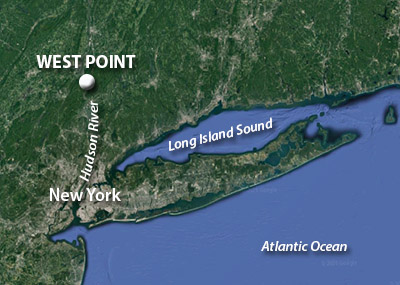 |
|
Washington appointed Polish military engineer Andrzej Tadeusz Bonawentura Kościuszko (1746-1817) to design the defenses of West Point in 1778. Kościuszko had previously built fortifications on the banks of the Delaware River in the hope of dissuading the British from using that waterway as a means of approach to Philadelphia, and had also spent time at wond'rous starfort Fort Ticonderoga. |
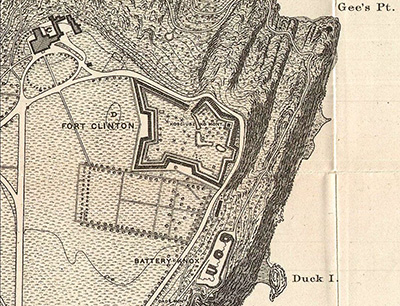 Fort Clinton (née Arnold), as presented in an 1883 map. |
 |
|
|
|
The name Benedict Arnold would of course go on to become every American's textbook definition of traitorous duplicity after he conspired, as commander of Fortress West Point, to hand his command over to the British in 1780. His dastardly deed was discovered and defused before West Point could be duly delivered, and Arnold defected. Clearly Fort Arnold could no longer be known as Fort Arnold, so it was renamed Fort Clinton, after Brigadier General James Clinton (1736-1812).
|
Clinton spent most of the American Revolutionary War on the New York frontier, and commanded a different Fort Clinton about five miles south of West Point, built to defend yet another chain across the Hudson River. I'm sure he was a great guy and all, but two starforts named for the same dude within five miles of one another?! Surely there were rules about such things.
But we're talking about Fort Putnam, which was named for Rufus Putnam (1738-1824), who served in the French and Indian War (1756-1763) as a Colonial Officer, and as a Lieutenant Colonel during the Revolution. Putnam was a millwright when not marching around in uniform, and his knowledge of construction and machinery prepared him to build fortifications that saved the day at a number of battles with the British.
|
 |

Fort Putnam as it appeared, sort of, in 1783. Click the image to see a 1783 map of the whole of West Point...along with a cross-section of Fort Putnam, which certainly doesn't seem illustrative of anything significant to me, but somebody took the time to draw it, so it was clearly significant to someone. |
|
George Washington named Putnam Chief of Engineers of the Works of New York, in which position he pressed Congress for the creation of a national corps of engineers. The United States to this point had depended on foreign engineers (persons with names such as "Kościuszko") for the design and construction of its major fortifications, as the young nation had no institution with which to train its own engineers. While this worked as an effective stopgap measure, relations betwixt nations are a finicky thing, and Putnam foresaw the possibility of former allies becoming enemies, which could leave the US without any trained engineers. Congress at that time possessed no such foresight, however, and turned him down. In 1776 Putnam resigned his commission in protest.
|
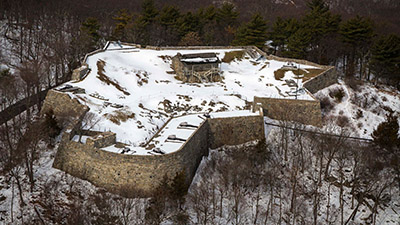
The irregular (yet charming) shape of Fort Putnam in the snow. |
 |
Putnam reenlisted the following year, and served in the Northern Army under Major General Horatio Gates (1727-1806), most notably at the Battle of Saratoga in October of 1777. Which brings us, at long last, to the starfort which bears his name.
Tadeusz Kościuszko convinced the authorities that a fortification at West Point atop Crown Hill, sited to defend Fort Clinton's back door, would be a worthwhile endeavor. He designed the fort, and on April 11 1778, Rufus Putnam arrived on the scene with 300 men of the 5th Massachusetts Regiment, and began construction of the fort.
|
|
|
The intended garrison for Fort Putnam was 420, but most of these troops would have been housed in tents outside the fort, which makes one wonder at the concept of "garrison." In 1780, Fort Putnam was armed with five 18-pounder guns, two 12-pounders, two 6-pounders, one 4-pounder and four 5.5" mortars. Fort Putnam was fully manned through the rest of the war, but was suitably terrifying to the British that it was never attacked...or, the war had moved on from West Point by the time of its construction. In 1794 the fort was rebuilt, becoming one of relatively few (and one of the first!) forts of America's First System of fortification. Fort Putnam was enlarged at this time, adding two interior casemates.
|
US Army "Cadets" began receiving informal instruction in artillery and engineering at the works of Fortress West Point in 1794, and shortly after his inauguration in 1801, President Thomas Jefferson (1743-1826) ordered that a United States Military Academy should be established there. Likely avoiding eye contact with Rufus Putnam, Congress approved the president's directive and the academy officially began operations on July 4, 1802.
Around this same time, Fort Putnam was abandoned. Though at the center of an active military base, its services were no longer required, and the fort began an inexorable slide into ruin.
|
 |
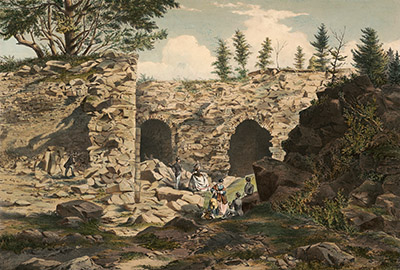 Old Casemates - interior Fort Putnam, West Point, an 1859 lithograph by Charles Parsons, from the Yale University Art Gallery. Old Casemates - interior Fort Putnam, West Point, an 1859 lithograph by Charles Parsons, from the Yale University Art Gallery. |
|
This sad state of affairs continued until 1909, when Fort Putnam was restored to an "approximation" of its 1794 appearance. Further restoration took place in 1975, in the interest of preparing Fort Putnam for an onslaught of Bicentennial tourism in 1976. At this time replica artillery and mortars were added to "approximate" the fort's armament of 1780. "Approximately."
|
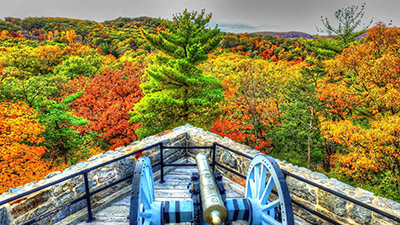 The view from Fort Putnam's western bastion, with no photo manipulation whatsoever. Thanks, XfactorAerial.com! The view from Fort Putnam's western bastion, with no photo manipulation whatsoever. Thanks, XfactorAerial.com! |
 |
First occupied by the Continental Army in 1778, West Point is the oldest continuously-operating army post in the United States. Fort Putnam is available for visits by the public, but only through a series of security steps for which I was not bright enough to prepare myself when I attempted to tour the fort in August of 2016. Being on an active military base, casual visits to the fort are discouraged by guys with guns at the base's gates. West Point Tours runs daily two-hour tours of Fort Putnam, emanating from the neighboring town of Highland Falls.
|
|
|
|
|
|
|
 |




